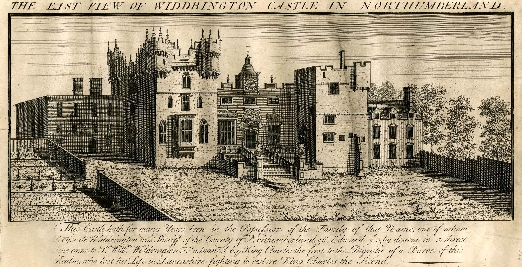
Northumberland is full of ruined castles that draw tourists year after year to imagine how magnificent they must have once looked. But, it is also filled with sites where castles once stood, that today there remains little or no trace of. One such site is Widdrington in Northumberland, not far from Druridge Bay. This is where Widdrington Castle stood from the 14th century until its demolition in the 19th century.
The first records of a structure at this site describe a medieval fortified manor house and castle. In 1341 Gerard Widdrington was granted a licence to fortify the house. The engraving shows a substantial tower with turrets at the corners, similar to the castle at nearby Belsay. By 1592 the castle had three parts: the original tower, a great hall and a northern tower. In the late 17th century wings were added to the towers, and a walled garden was laid out. However, by 1720 and with new owners, it was in a ruinous condition. Sometime after 1772 the castle was demolished and rebuilt, but the new building burnt down before it was finished. After this a new Gothic castle was built, but this too fell to ruin and was demolished in 1862. The dilapidated state in which the castle found itself many times over the years probably owed much to the fact that it was rarely the main residence of the families who owned it, and lack of use caused it to fall into disrepair.
Widdrington Castle’s claim to fame is that King James VI of Scotland and I of England was believed to have stayed at the castle in 1603. Sir Robert Carey, the second cousin of Queen Elizabeth I, who married the widow of Henry Widdrington in 1593, rested here during his journey from London to Edinburgh to inform James of Elizabeth’s death. On James’ journey south to claim the throne the men are said to have stayed at Widdrington.
The Widdrington family themselves were Catholic and Royalist and therefore strong supporters of the Stuart cause. The first baron was a Royalist army officer, the second baron served in the army of Charles II, and during the revolution of 1688 the third baron was dismissed as governor of Berwick and Holy Island and imprisoned. His three sons, William, Charles and Peregrine, all became active Jacobites.
The fourth baron, William Widdrington (1677/8-1743) was educated at Morpeth grammar school and in Paris where he became familiar with the exiled Stuart court. He took a leading role in planning the north’s contribution to the Jacobite rising of 1715, providing one of the five troops in the Northumbrian force. However, he was confined to his bed with gout during the Battle of Preston, and when it was clear that the situation was hopeless he advised surrender. After the failed rising he was tried for high treason. In his defence he argued that he had not been aware of the plan and had only joined to keep face with his friends. He was found guilty and sentenced to death, but with only hours to spare he was reprieved and released from the Tower. The Widdrington estates were confiscated by the Crown and sold to Sir George Revel. The estate then passed via marriage to Sir George Warren and then on to Lord Vernon. An attainder was passed on the family titles although Widdrington’s eldest son, Henry Francis, was commonly called Lord Widdrington. Following the death of Henry in 1774 the Widdrington family appears to have become extinct.
The site of Widdrington Castle is a Scheduled Ancient Monument. All that remains of the protected site today is the Castle mound and a row of lime trees, known as The Apostles. The site lies close to The Country Barn in Widdrington, which uses the castle as its logo.
